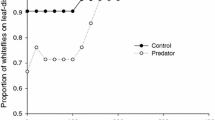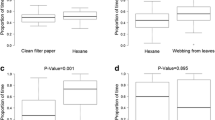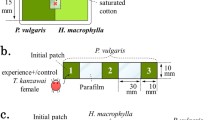Abstract
Some of the processes that control or influence the movements of females of the predatory mitePhytoseiulus persimilis Athias-Henriot when dispersing between plants are studied here. Experiments on the preference for light or shadow, carried out in a choice chamber, showed that individuals that have been starved for longer or in environments with lower relative humidities have a stronger preference for shaded places. Whilst the speed of movement is independent of the starvation level, the net speed (i.e. measuring the distance traversed in a bee-line) increases and the turning tendency decreases with the time the animals have been deprived of food. The longevity of starving females increases with the relative humidity of the environment where they were kept. These results are compared with similar data for the spider miteTetranychus urticae Koch in order to discuss their possible effect on the dynamics on the predator-prey system they form.
Résumé
Dans ce travail on étudie quelques-uns des processus qui contrôlent ou influencent le mouvement des femelles de l'acarien prédateurPhytoseiulus persimilis Athias-Henriot quand elles se déplacent d'une plante à l'autre.
Des expériences réalisées pour étudier la préférence pour la lumière ou l'ombre des femelles deP. persimilis ont montré que plus la période durant laquelle elles ont été privées de nourriture est longue, ou plus basse est l'humidité relative du milieu où elles ont été maintenues, plus grande est leur préférence pour les lieux ombragés.
Tandis que la vitesse de déplacement est indépendante du degré d'inanition de l'animal, la vitesse nette appréciée en mesurant la distance entre le point initial et le point final en ligne droite, augmente avec le temps pendant lequel les acariens ont été privés de nourriture, tandis que la tendance à changer de direction diminue.
La longévité des femelles privées de nourriture (c'est-à-dire dans des conditions similaires à celles où elles se trouvent quand elles se déplacent entre les plantes) augmente avec l'humidité relative du milieu dans lequel elles ont été maintenues. Le rapport possible entre ce fait et le changement de la préférence pour la lumière ou l'ombre est discuté.
On compare les résultats obtenus avec des données similaires pour l'acarien phytophageTetranychus urticae Koch pour discuter sa possible influence sur la dynamique du système proie-prédateur.
Similar content being viewed by others
References
Bernstein, C. — 1981. Dispersal ofPhytoseiulus persimilis [Acarina: Phytoseiidae] in response to prey density and distribution. —Ph. D. thesis. Univ. Oxford.
Burnett, T. — 1979. An acarine predator-prey population infesting roses. —Res. Popul. Ecol., 20, 227–234.
Charlet, L.D. &McMurtry, J.A. — 1977. Systematics and bionomics of predacious and phytophagous mites associated with pine foliage in California. Il: Population dynamics of mites on three species of pines in Forest Falk area of the San Bernardino Mountains. —Hilgardia, 45, 211–222.
Comins, M.H. &Blatt, D.W.E. — 1974. Prey predator models in spatially heterogeneous environments. —J. Theor. Biol., 48, 75–83.
Everson, P. — 1980. The relative activity and functional response ofPhytoseiulus persimilis [Acarina: Phytoseiidae] andTetranychus urticae [Acarina: Tetranychidae]: the effect of temperature. —Can. Entomol., 112, 17–24.
Flaherty, D.L. &Huffaker, C.B. — 1970. Biological control of pacific mites in San Joaquin Valley vineyards. Il: Influence of dispersion patterns ofMetaseiulus occidentalis. —Hilgardia, 40, 309–330.
Gunther, F.A. &Jeppson, T. — 1960. Modern insecticides and world food production. —Chapman & Hall, London.
Hassell, M.P. — 1978. The dynamics of arthropod predator-prey systems. —Princeton Univ. Press, Princeton.
Hassell, M.P. &May, R.M. — 1974. Aggregation of predators and insect parasites and its effects on stability. —J. Anim. Ecol., 43, 567–594.
Hilborn, R. — 1975. The effects of spatial heterogeneity on the persistence of predator-prey interactions. —Theor. Popul. Biol., 8, 346–355.
Huffaker, C.B. — 1958. Experimental studies on predation. II: Dispersion factors and predatorprey oscillations. —Hilgardia, 27, 343–383.
Huffaker, C.B., Shea, K.P. &Herman, S.G. — 1963. Experimental studies on predation. —Hilgardia, 34, 305–335.
Murdoch, W.W. — 1977. Stabilizing effects of spatial heterogeneity in predator-prey systems. —Theor. Popul. Biol., 11, 252–273.
Murdoch, W.W. &Oaten, A. — 1975. Predation and population stability. —Adv. Ecol. Res., 9, 2–131.
Nachman, G. — 1981. Temporal and spatial dynamics of an acarine predator-prey system. —J. Anim. Ecol., 50, 435–451.
Pimentel, D., Nagel, W.P. &Madden, J.L. — 1963. Space-time structure of the environment and survival of parasite-host systems. —Am. Nat., 97, 141–167.
Putnam, W.L. — 1962. Life history and behaviour of the predacious miteTyphlodromus (T.)caudialans Schister in Ontario with notes on the prey related species. —Can. Entomol., 94, 163–177.
Redshaw, J.L. — 1975. The ecology ofTetranychidae mites in Australian orchads. —J. Appl. Ecol., 12, 473–495.
Sabelis, M.W. — 1981. Biological control of two spotted spider mites using phytoseiid predators. Part 1. Modelling the predator-prey interaction at the individual level. —Agric. Res. Reports 910,Pudoc, Wageningen.
Sandness, J.M. &McMurtry, J.A. — 1972. Prey consumption behaviour ofAmblyseius largoensis in relation to hunger. —Can. Entomol., 104, 461–470.
Sorensen, J.T., Kin, D.N., Doutt, R.L. &Cate, J.R. — 1976. Biology of the miteAnystis agilis [Acari: Anystidae] a California vineyard predator. —Ann. Entomol. Soc. Am., 69, 905–910.
Suski, Z.W. &Naegele, J.A. — 1963. Techniques for the study of light response in the two-spotted spider mite. — In: Advances in acarology. (J.A. Naegele, ed.) —Comstock, Ithaca, vol. 1, 193–198.
Suski, Z.W. &Naegele, J.A. — 1963a. Light response in the two-spotted spider mite. I: Analysis of behavioural response. In: Advances in Acarology. (J.A. Naegele, ed.) —Comstock, Ithaca, vol. 1, 435–444.
Suski, Z.W. &Naegele, J.A. — 1963b. Light response in the two-spotted spider mite. Il: Behaviour of the “sedentary” and “dispersal” phases. In: Advances in Acarology. (J.A. Naegele, ed.) —Comstock, Ithaca, vol. 1, 445–453.
Takafuji, A. — 1977. The effects of successful dispersal of a phytoseiid mitePhytoseiulus persimilis Athias-Henriot [Acarina: Phytoseiidae] on the persistence in the interactive system between the predator and its prey. —Res. Popul. Ecol., 18, 210–222.
Yao, D. — 1977. A study of the effects of predator and prey densities on the behaviour of the predatory mitePhytoseiulus persimilis, in the laboratory. —M. Sc. Thesis, Univ. of Oxford.
Youdeowei, A. — 1977. A Laboratory Manual of Entomology. —Oxford Univ. Press, Ibadan, Nigeria.
Author information
Authors and Affiliations
Rights and permissions
About this article
Cite this article
Bernstein, C. Some aspects ofPhytoseiulus persimilis [Acarina: Phytoseiidae] dispersal behaviour. Entomophaga 28, 185–198 (1983). https://doi.org/10.1007/BF02372143
Issue Date:
DOI: https://doi.org/10.1007/BF02372143




